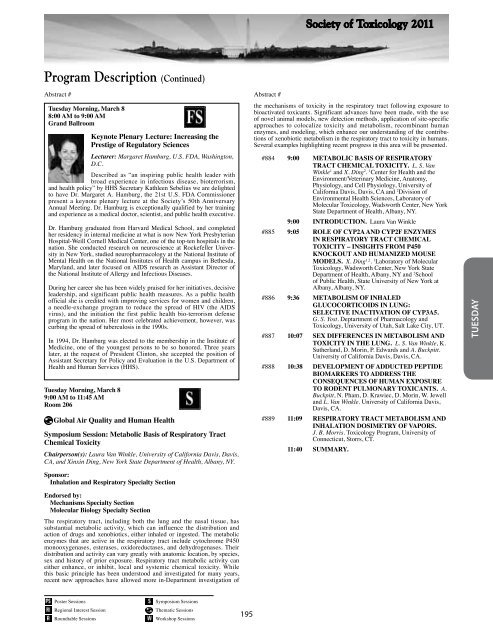Program - Society of Toxicology
Program - Society of Toxicology
Program - Society of Toxicology
Create successful ePaper yourself
Turn your PDF publications into a flip-book with our unique Google optimized e-Paper software.
<strong>Society</strong> <strong>of</strong> <strong>Toxicology</strong> 2011<br />
<strong>Program</strong> Description (Continued)<br />
Abstract #<br />
Tuesday Morning, March 8<br />
8:00 AM to 9:00 AM<br />
Grand Ballroom<br />
Keynote Plenary Lecture: Increasing the<br />
Prestige <strong>of</strong> Regulatory Sciences<br />
Lecturer: Margaret Hamburg, U.S. FDA, Washington,<br />
D.C.<br />
Described as “an inspiring public health leader with<br />
broad experience in infectious disease, bioterrorism,<br />
and health policy” by HHS Secretary Kathleen Sebelius we are delighted<br />
to have Dr. Margaret A. Hamburg, the 21st U.S. FDA Commissioner<br />
present a keynote plenary lecture at the <strong>Society</strong>’s 50th Anniversary<br />
Annual Meeting. Dr. Hamburg is exceptionally qualified by her training<br />
and experience as a medical doctor, scientist, and public health executive.<br />
Dr. Hamburg graduated from Harvard Medical School, and completed<br />
her residency in internal medicine at what is now New York Presbyterian<br />
Hospital-Weill Cornell Medical Center, one <strong>of</strong> the top-ten hospitals in the<br />
nation. She conducted research on neuroscience at Rockefeller University<br />
in New York, studied neuropharmacology at the National Institute <strong>of</strong><br />
Mental Health on the National Institutes <strong>of</strong> Health campus in Bethesda,<br />
Maryland, and later focused on AIDS research as Assistant Director <strong>of</strong><br />
the National Institute <strong>of</strong> Allergy and Infectious Diseases.<br />
During her career she has been widely praised for her initiatives, decisive<br />
leadership, and significant public health measures. As a public health<br />
<strong>of</strong>ficial she is credited with improving services for women and children,<br />
a needle-exchange program to reduce the spread <strong>of</strong> HIV (the AIDS<br />
virus), and the initiation the first public health bio-terrorism defense<br />
program in the nation. Her most celebrated achievement, however, was<br />
curbing the spread <strong>of</strong> tuberculosis in the 1990s.<br />
In 1994, Dr. Hamburg was elected to the membership in the Institute <strong>of</strong><br />
Medicine, one <strong>of</strong> the youngest persons to be so honored. Three years<br />
later, at the request <strong>of</strong> President Clinton, she accepted the position <strong>of</strong><br />
Assistant Secretary for Policy and Evaluation in the U.S. Department <strong>of</strong><br />
Health and Human Services (HHS).<br />
Tuesday Morning, March 8<br />
9:00 AM to 11:45 AM<br />
Room 206<br />
Global Air Quality and Human Health<br />
Symposium Session: Metabolic Basis <strong>of</strong> Respiratory Tract<br />
Chemical Toxicity<br />
Chairperson(s): Laura Van Winkle, University <strong>of</strong> California Davis, Davis,<br />
CA, and Xinxin Ding, New York State Department <strong>of</strong> Health, Albany, NY.<br />
Sponsor:<br />
Inhalation and Respiratory Specialty Section<br />
Endorsed by:<br />
Mechanisms Specialty Section<br />
Molecular Biology Specialty Section<br />
The respiratory tract, including both the lung and the nasal tissue, has<br />
substantial metabolic activity, which can influence the distribution and<br />
action <strong>of</strong> drugs and xenobiotics, either inhaled or ingested. The metabolic<br />
enzymes that are active in the respiratory tract include cytochrome P450<br />
monooxygenases, esterases, oxidoreductases, and dehydrogenases. Their<br />
distribution and activity can vary greatly with anatomic location, by species,<br />
sex and history <strong>of</strong> prior exposure. Respiratory tract metabolic activity can<br />
either enhance, or inhibit, local and systemic chemical toxicity. While<br />
this basic principle has been understood and investigated for many years,<br />
recent new approaches have allowed more in-Department investigation <strong>of</strong><br />
Abstract #<br />
the mechanisms <strong>of</strong> toxicity in the respiratory tract following exposure to<br />
bioactivated toxicants. Significant advances have been made, with the use<br />
<strong>of</strong> novel animal models, new detection methods, application <strong>of</strong> site-specific<br />
approaches to colocalize toxicity and metabolism, recombinant human<br />
enzymes, and modeling, which enhance our understanding <strong>of</strong> the contributions<br />
<strong>of</strong> xenobiotic metabolism in the respiratory tract to toxicity in humans.<br />
Several examples highlighting recent progress in this area will be presented.<br />
#884 9:00 METABOLIC BASIS OF RESPIRATORY<br />
TRACT CHEMICAL TOXICITY. L. S. Van<br />
Winkle 1 and X. Ding 2 . 1 Center for Health and the<br />
Environment/Veterinary Medicine, Anatomy,<br />
Physiology, and Cell Physiology, University <strong>of</strong><br />
California Davis, Davis, CA and 2 Division <strong>of</strong><br />
Environmental Health Sciences, Laboratory <strong>of</strong><br />
Molecular <strong>Toxicology</strong>, Wadsworth Center, New York<br />
State Department <strong>of</strong> Health, Albany, NY.<br />
9:00 INTRODUCTION. Laura Van Winkle<br />
#885 9:05 ROLE OF CYP2A AND CYP2F ENZYMES<br />
IN RESPIRATORY TRACT CHEMICAL<br />
TOXICITY – INSIGHTS FROM P450<br />
KNOCKOUT AND HUMANIZED MOUSE<br />
MODELS. X. Ding 1,2 . 1 Laboratory <strong>of</strong> Molecular<br />
<strong>Toxicology</strong>, Wadsworth Center, New York State<br />
Department <strong>of</strong> Health, Albany, NY and 2 School<br />
<strong>of</strong> Public Health, State University <strong>of</strong> New York at<br />
Albany, Albany, NY.<br />
#886 9:36 METABOLISM OF INHALED<br />
GLUCOCORTICOIDS IN LUNG:<br />
SELECTIVE INACTIVATION OF CYP3A5. <br />
G. S. Yost. Deptartment <strong>of</strong> Pharmacology and<br />
<strong>Toxicology</strong>, University <strong>of</strong> Utah, Salt Lake City, UT.<br />
#887 10:07 SEX DIFFERENCES IN METABOLISM AND<br />
TOXICITY IN THE LUNG. L. S. Van Winkle, K.<br />
Sutherland, D. Morin, P. Edwards and A. Buckpitt.<br />
University <strong>of</strong> California Davis, Davis, CA.<br />
#888 10:38 DEVELOPMENT OF ADDUCTED PEPTIDE<br />
BIOMARKERS TO ADDRESS THE<br />
CONSEQUENCES OF HUMAN EXPOSURE<br />
TO RODENT PULMONARY TOXICANTS. A.<br />
Buckpitt, N. Pham, D. Krawiec, D. Morin, W. Jewell<br />
and L. Van Winkle. University <strong>of</strong> California Davis,<br />
Davis, CA.<br />
#889 11:09 RESPIRATORY TRACT METABOLISM AND<br />
INHALATION DOSIMETRY OF VAPORS. <br />
J. B. Morris. <strong>Toxicology</strong> <strong>Program</strong>, University <strong>of</strong><br />
Connecticut, Storrs, CT.<br />
11:40 SUMMARY.<br />
Tuesday<br />
Poster Sessions<br />
Regional Interest Session<br />
Roundtable Sessions<br />
Symposium Sessions<br />
Thematic Sessions<br />
Workshop Sessions<br />
195
















